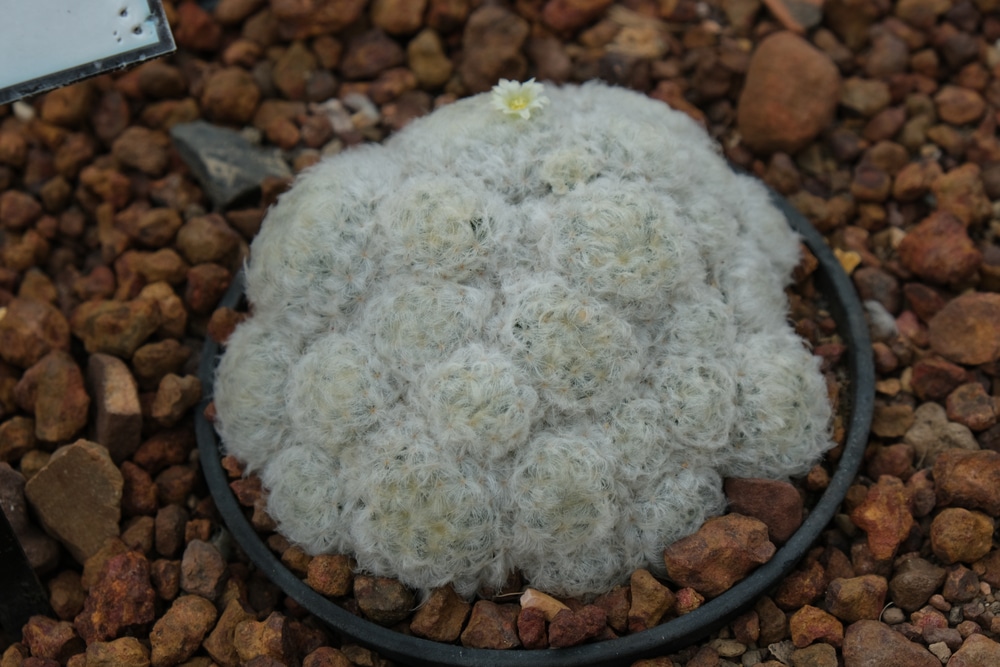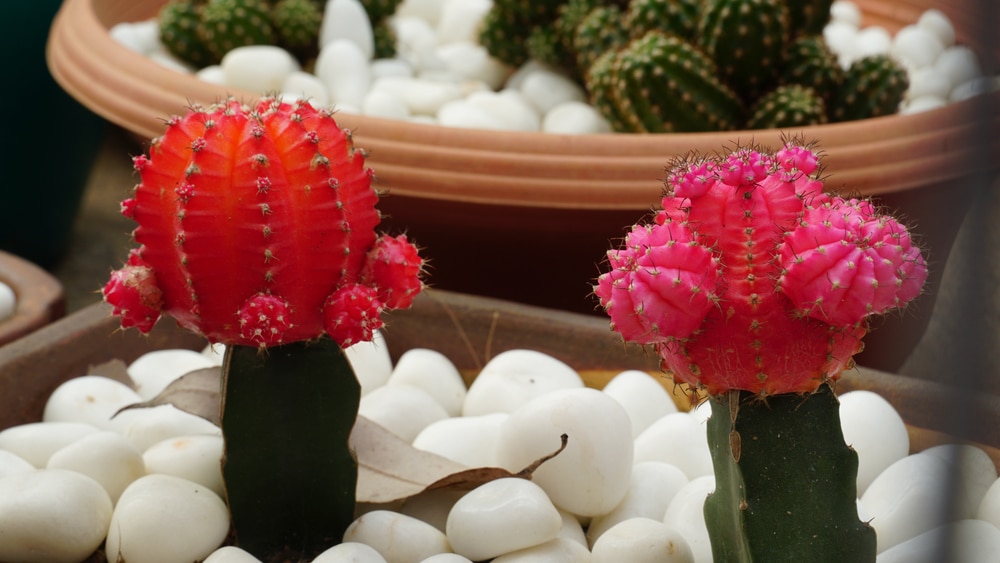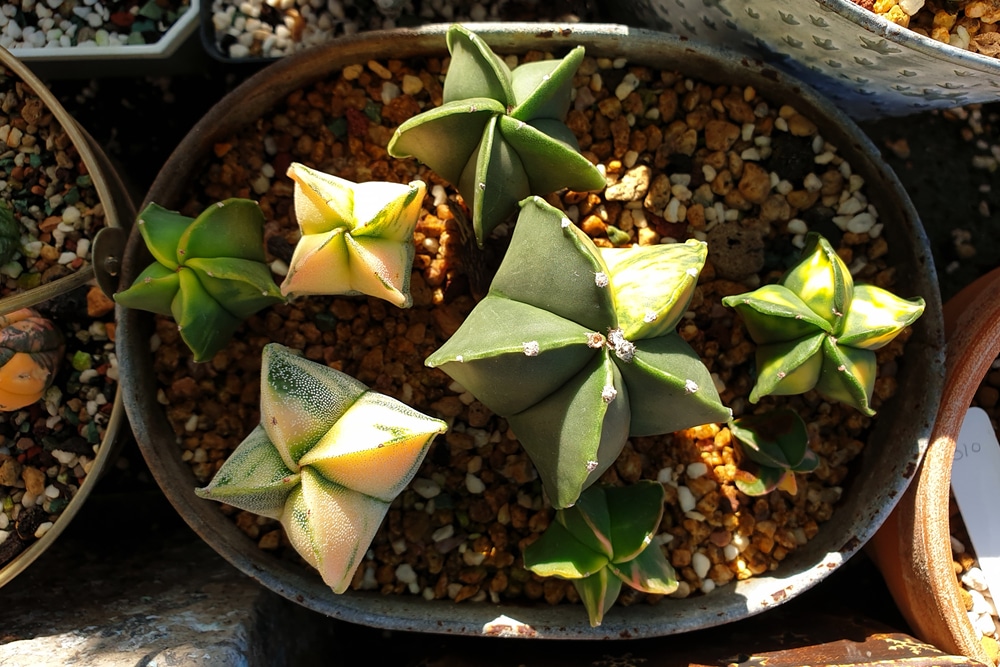Flower Glossary is reader-supported. When you buy through links on our site, we may earn an affiliate commission.
For those who are wanting to start gardening but haven’t been too successful in the past or wanting an easier start, a cactus is the best route to go down.
With their lovely appearance and unique maintenance that makes them incredibly easy to care for, purchasing a cactus will help to open your eyes to the world of plants and will instantly brighten up your home.
The majority of cacti are native to the Americas and are capable of resisting droughts. Thanks to their self-sustaining nature, they are perfect for all kinds of plant lovers, even those who struggle to stay on top of maintenance with other plant species.
Cacti can be placed both indoors and outdoors making them extremely versatile. As they thrive in sunlight, they are perfect for keeping on the window sill and can add a lot of life and vibrancy to any room.
But what are the best kinds of cactus plants that you can purchase? We’ve gathered the top 10 types of cactus plants that you should consider.
Table of Contents
1. Bunny Ear Cactus (Opuntia microdasys)
Our first recommendation is the Bunny Ear Cactus which is also known as Opuntia microdasys. Other common names for this cactus plant are: polka dot cactus, angel’s wings cactus, neon cactus, golden bristle cactus and bunny cactus.
The Bunny Ear Cactus gets its name from the shape of the stems that look like a rabbit’s ears.
This feature alone is enough to capture one’s attention but another great factor to remember is that it requires little to no maintenance, making it the perfect starter cactus for those who worry that they will forget to take care of their plants.
They can grow to be 90cm when planted outside. They also have white and yellow glochids which can brighten up any room. They do require a well drained container whether it is planted indoors or outdoors.
Be aware that pests can occasionally settle in this cast such as scale insects and mealybugs but these can be rid of using alcohol soaked cotton balls which won’t damage the plant.
The most popular varieties and subspecies of bunny ear cactus plants are: Opuntia microdasys var. Albispina, Opuntia microdasys var. Pallida, Opuntia microdasys var. pallida f. Cristata and Opuntia microdasys subs. Rufida
2. Fairy Castle Cactus (Acanthocereus tetragonus ‘Fairy Castle’)
Our second selection is the Fairy Castle Cactus which is also known as the Acanthocereus tetragonus which was formerly the Cereus tetragonus. Other common names for this plant are: fairytale castle cactus and green finger cactus.
The Fairy Castle Cactus can be found in a variety of places including North and South America and the Caribbean meaning that it is one of the most commonly found cactus plants available.
Featuring a unique form, this cactus garners its name from the varying branches that differ in height which resembles turrets giving it the castle related name.
The main stem of the cactus has five sides which feature spines along the rib that are a creamy white color and have a bristled texture throughout. This cactus is slow growing so is perfect for those who want a plant that is going to last a long time.
What makes the Fairy Castle Cactus so unique is that it rarely blooms its flowers but when they do appear, the flowers are beautiful white and yellow. They can grow as tall as 3 feet making them an appropriate size for both indoor and outdoor use.
3. Feather Cactus (Mammillaria plumosa)
Our third choice is the Feather Cactus which is also known as the Mammillaria plumosa. Another common name for this cactus is the golf ball cactus thanks to its signature shape.
The Feather Cactus has a clustered structure as it forms a pile of stems. Growing up to 5 inches tall, this cactus gets its name thanks to the white feathers that cover the entire surface area of the plant.
These feathers are actually filled with extremely fine spines that are very sharp beneath the surface.
This is a great choice for those who don’t want to spend a long time fussing over their plant as the feathers stop the cactus from receiving too much heat and sunlight, meaning that it pretty much preserves itself.
With a variety of different colored flowers that can appear including white, yellow, green and pink, the Feather Cactus is a wonderful choice for those who want to fill their home with a lot of colorful plants during the summertime without worrying about them dying.
This cactus can be found in Northeastern Mexico in the desert environments.
The most popular variety of feather cactus plant is the Mammillaria plumosa var. Roseiflora.

4. Golden Barrel Cactus (Echinocactus grusonii)
Our fourth recommendation is the Golden Barrel Cactus which is also known as the Echinocactus grusonii. Other common names for this cactus are the: barrel cactus, mother-in-law’s cushion cactus, mother-in-law’s seat cactus and the golden ball cactus.
The Golden Barrel Cactus is one of the most popular houseplants thanks to its globe shaped sole that is ribbed and lined with yellow spines.
The top part of the plant is covered with thick woolen hair that helps to protect it from too much sunlight exposure. They are slow growing and can withstand shaded spots making them versatile for all kinds of households.
The yellow flowers that bloom from this cactus are cup shaped and often bloom when the plant has fully matured. Native to Mexico, this cactus is one of the best choices for those who have temperamental weather as it can thrive in sunlight and shade.
The most popular varieties and forms of golden barrel cactus plants are the: Echinocactus grusonii var. Albispina, Echinocactus grusonii cristata, Echinocactus grusonii var. Curvispinus, Echinocactus grusonii f. Monstruosas, Echinocactus grusonii var.
Brevispinus, Echinocactus grusonii var. brevispinus f. Cristata, Echinocactus grusonii setispinus mostruosa and the Echinocactus grusonii var. Intermedius.
5. Holiday Cacti
Our fifth selection is the Holiday Cacti which are a variety of cacti that grow at certain times of the year and therefore coincide with certain holidays throughout the year. Depending on the cactus, they can grow flowers in all kinds of colors which make for a lovely gift.
The Holiday Cacti are: Christmas Cactus, Easter Cactus and Thanksgiving Cactus.
The first Holiday Cacti is the Christmas Cactus which is also known as Schlumbergera bridgesii and is similar in appearance to the Thanksgiving Cactus. However, the shapes of the stems are the main difference as the Christmas Cactus has a flattened stem with rounded edges.
It blooms red and pink flowers during the winter months, hence why it is known as the Christmas Cactus. Growing up to 10 inches in height, this is a perfect cactus for both indoor and outdoor use.
It is native to southern Brazil, especially the mountain areas, meaning that it can withstand a certain amount of shade.
The second Holiday Cactus is the Easter Cactus which is known as the Rhipsalidopsis gaertneri. Other common names for this cactus is the spring cactus or the whitsun cactus.
It is a perennial cactus that can grow up to 25 inches making it ideal for outdoor gardening. It is also native to southern Brazil and has a flattened stem that is divided into long segments that have smoother edges covered in soft hairs.
With leafy segments that are pale green, this cactus grows darker as it matures. The Easter Cactus has the most color range in its flowers and can bloom red, white, lavender or orange flowers depending on what specific variety you have selected.
The third kind of Holiday Cactus is the Thanksgiving Cactus which is also known as the Schlumbergera truncata. Other common names for this cactus are the crab cactus and the false Christmas cactus.
The Thanksgiving Cactus is native to the forests of Brazil and is often confused with the Christmas cactus due to their similar shapes and close blooming times.
However, as expected, this cactus blooms a little bit earlier than Christmas and also has tubular shaped flowers and sharper edges which is different to the aesthetic of the Christmas cactus. Depending on the variety, the flowers can be either red, purple, white or pink.
With the ability to grow up to 12 inches in height, this cactus can be kept indoors or outdoors but does thrive better when kept in the latter.
6. Moon Cactus (Gymnocalycium mihanovichii)
Our sixth choice is the Moon Cactus which is also known as the Gymnocalycium mihanovichii. Its other common names are the hibotan cactus and the chin cactus.
The Moon Cactus is most commonly used for outdoor gardens. What makes this form of cacti unique is that they don’t produce chlorophyll and need a stock cactus that produces the pigment so they can thrive in their environment well.
This mutation causes the top of the cactus to be a different color such as red, yellow, purple, pink or orange. Native to South America, this cactus is often found in the desert regions as they require as much sunlight as possible.
Although they thrive more in an outdoor environment, they can be grown indoors if they are exposed to plenty of sunlight.
They are smaller cacti when compared to others as they only reach an average of 0.5 inches in width but they can instantly change the mood of a room thanks to their vibrant and beautiful colors which is what makes them such a popular choice.
The most popular cultivars of moon cactus plants are: the Gymnocalycium mihanovichii var. friedrichii ‘Hibotan’, Gymnocalycium mihanovichii’ Hibotan Nishiki’, Gymnocalycium mihanovichii var. friedrichii ‘Pink-Kuro’ and the Gymnocalycium mihanovichii var. friedrichii ‘Akagurohibotan-Nishiki’.

7. Old Lady Cactus (Mammillaria hahniana)
Our seventh recommendation is the Old Lady Cactus which is also known as the Mammillaria hahniana. Other common names for this cactus are the old lady pincushion cactus and the birthday cake cactus.
The Old Lady Cactus is ideally kept under direct sunlight and is similar to cacti under the pincushion cactus genus. Native to Mexico, this is one of the most popular choices for indoor planting.
With white spines and hairs, this cactus can grow up to 4 inches in height making it ideal for those who want to improve their rooms. While it is growing, the stem is completely circular in appearance but straightens out a bit more as it grows and matures over time.
As this is happening, red and purple flowers can start to appear at the top of the sphere which is what makes it so recognizable around the world. The flowers are large and can go as wide as 15mm in diameter and last through the spring and summer months.
Requiring little care and maintenance, this is an ideal species to sit under the sun and let nature do its work. Make sure you have a sufficient draining holder so it doesn’t hold too much moisture over time.
The most popular varieties, subspecies, and forms of old lady cactus plants are: Mammillaria hahniana f. albiflora which is the white flowering form, Mammillaria hahniana var. Gisela, Mammillaria hahniana var.
Werdermanniana, Mammillaria hahniana subs. Bravoae, Mammillaria hahniana subs. Mendeliana and the Mammillaria hahniana subs. Woodsii.
8. Spiny Pincushion Cactus (Mammillaria spinosissima)
Our eighth selection is the Spiny Pincushion Cactus which is also known as the Mammillaria spinosissima. Other common names for this cactus are the red headed Irishman cactus and the Irish red head cactus.
The Spiny Pincushion Cactus is one of the most well recognized thanks to its signature appearance and common sightings over its native Mexico.
This plant gets its name from the needle-like spines that cover the majority of the cactus’ surface area. These spines are either a red-brown shade or white which makes it stand out immediately from other similar cacti species.
On the other hand, the stems appear to have a darker green coloring with a cylindrical shaping. If taken care of correctly, deep pink and purple flowers will bloom from this cactus during the springtime.
They are situated at the top of the plant rather than the sides and form a ring structure at its tip.
The most popular varieties, subspecies, and forms of spiny pincushion cactus plants are: Mammillaria spinosissima var. auricoma, Mammillaria spinosissima var. auricoma f. Cristata, Mammillaria spinosissima ’Un Pico’ and the Mammillaria spinosissima var. sanguinea.
9. Star Cactus or Sand Dollar Cactus (Astrophytum asterias)
Our penultimate choice is the Star Cactus or Sand Dollar Cactus which is also known as the Astrophytum asterias. Other common names for this cactus are: the sea urchin cactus or the star peyote.
The Star Cactus is a smaller and rounded cactus plant that can be found in Mexico and Texas. They can grow up to be around 7cm tall making them perfect for those who want a smaller plant that can be kept indoors.
They have around eight triangular ridges which can be viewed clearly from looking over the top. During the springtime, yellow and orange flowers with orange and red centers will appear.
These flowers can grow to around 15cm wide making them extremely beautiful and colorful. They can also grow green and pink fruits that are covered in a wooly hair.
This cactus is the perfect choice for those who are nervous about owning succulents but want a plant that has beautiful flowers that will definitely bloom. Unlike other cacti where they may not bloom at all, this is guaranteed to give any room a bit of vibrancy.
The most popular cultivars of sand dollar cactus plants are: Astrophytum asterias’ Super Kabuto’, Astrophytum asterias’ Ooibo Kabuto’ and the Astrophytum asterias’ Shinshowa Red’.

10. Totem Pole Cactus (Lophocereus schottii var. monstruosa)
Our final recommendation is the Totem Pole Cactus which is also known as the Lophocereus schottii var. Mostruosa. It’s other common names are: totem cactus and monstrous whisker cactus.
The Totem Pole Cactus is a slow growing cactus that features a tall and slim stem that branches out at its base.
Once fully matured, this cactus can grow to around 3m tall but it has also been known to grow up to 6m. The Totem Pole Cactus is known for its irregularly shaped ribs that have raised swellings along the sides which gives it a quirky appearance.
Its flowers rarely bloom but when they do, it has pink flowers that add a beautiful element of color. The important thing to remember about this species of cactus is that they crave full sunlight exposure.
Having them in partial shade is tolerated but they won’t thrive as much. This is why they are native to sunny climates such as Arizona and Mexico.